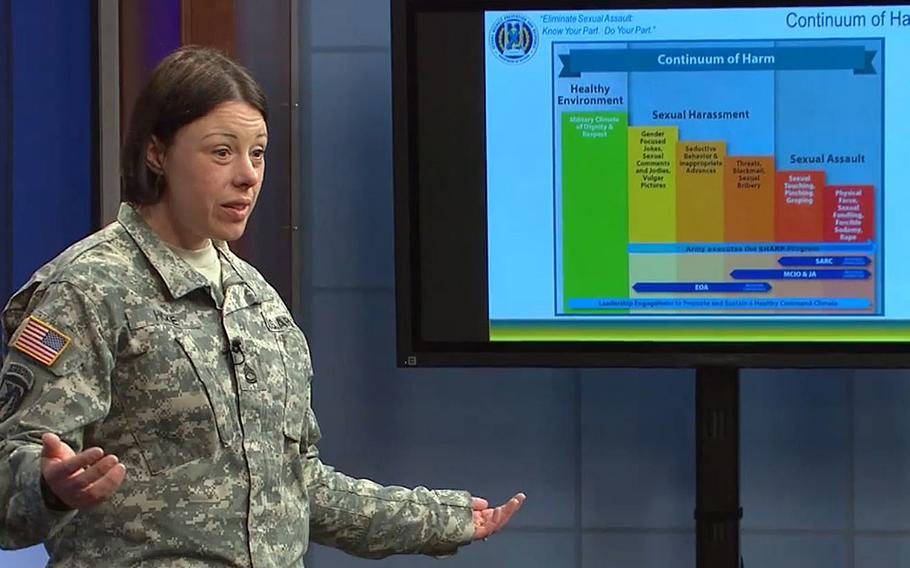
A video screen grab shows a military sexual assault response and prevention coordinator for Fort Meade, Md., giving a lecture on April 16, 2015. (Defense Department)
Too little progress has been made in countering perceptions of retaliation felt by those who report a sexual assault, and all the services must take measures to protect victims and others who report wrongdoing from reprisals, especially from peers, Pentagon officials concluded from an annual report on sexual assault in the military.
About two thirds of female troops who are sexually assaulted and report those attacks believe they experience retaliation afterward, according to the report.
“We’re not making enough progress on countering retaliation,” Defense Secretary Ash Carter said at a news conference when the report was released Friday. “Too many servicemembers, the data shows, feel that when they report or try to stop these crimes, they’re being retaliated against in some way.”
The retaliation numbers, which are unchanged from 2012, come from a survey done late last year, and were first released in December. At the time, then-Defense Secretary Chuck Hagel announced new training and an additional study designed in part to prevent retaliation.
Carter said that while the newly released report contains very similar “top-line” numbers as the one released in December, it provides more detail and information about where the Pentagon needs to improve, and how.
“The report makes it crystal clear that we have to do more,” he said. “Based on what we're learning about retaliation, especially from one's peers, I'm directing that we develop a DOD-wide comprehensive strategy to prevent retaliation against servicemembers who report or intervene on behalf of victims of sexual assault and other crimes.”
According to the report, 6,131 sexual assaults involving at least one servicemember were reported to the military in fiscal 2014. Of those who reported, 62 percent of women surveyed perceived negative consequences of speaking out, according to an anonymous survey of about 150 victims. Not enough men responded to the survey for accurate data to be available for men.
The total number of reports of sexual assaults is up 11 percent over the previous year, and 70 percent over 2012, but officials said increased reporting is a sign of better confidence in the system. Based on an anonymous survey given last year, officials believe 20,300 servicemembers experienced a sexual assault last year, down from an estimated 26,000 in 2013.
Nate Galbreath, senior executive advisor for the DOD’s Sexual Assault Prevention and Response Office, said the increase in official reports is a positive development, particularly with a decrease in the number of estimated attacks, which may mean the military is closing the “reporting gap.”
Sexual assault is an underreported crime in general, he said, but increased reporting of attacks means the military can help victims, and identify attackers and hold them responsible.
But the numbers also show that 22 percent of women and seven percent of men experienced sexual harassment last year, and that those who experience harassment are more likely to be sexually assaulted, Cater said.
“That’s abhorrent and has to stop,” he said. “We have to better attack permissive behaviors like sexual harassment.”
Sen. John McCain, R-Ariz. and chairman of the Senate Armed Services Committee, praised the “critical progress” he said has been made on reducing sexual assault and harassment.
But Sen. Kirsten Gillibrand, D-N.Y., called the report “more of the same.”
Gillibrand, who has championed legislation that would remove prosecution authority from the victim and accused attacker’s chain of command, said she is concerned that despite repeated promises and new laws, there has still been no progress on reducing retaliation.
“It’s time to say enough is enough,” she said. “The men and women of our military deserve a system of justice worthy of their sacrifice.”
Last year, the services implemented new regulations to strengthen rules that prohibit retaliation, ostracism or maltreatment.
Erica Hunt, interim executive director of Service Women’s Action Network, said she expected to see more improvements.
“This report calls into question whether or not the reforms related to sexual assault prevention have been the right reforms,” she said. “Incremental reforms have resulted in only incremental change. At this rate, any meaningful progress would take decades.”
Still, Galbreath said not all of the perceived retaliation necessarily qualifies as such under the Uniform Code of Military Justice.
"After you experience trauma, the world is a much darker place,” said Galbreath, a clinical psyschologist who has treated victims of sexual assault.
The report also provided additional information about the difference in reporting and circumstances between male and female victims.
Though defense officials estimate 10,400 men and 8,500 women were victims of sexual assault in 2014, only 1,082 men reported being assaulted. That means just 10 percent of male victims reported their assaults, compared with about 43 percent of women, according to the report.
Men are more likely to experience multiple attacks from multiple offenders, and also more likely to view the assaults as non-sexual hazing or attempts to humiliate, Galbreath said.
Carter asked the services to update prevention training to incorporate what the DOD has learned from the reports, to look at how to best meet the needs of male and female victims of sexual assault, and to develop a DOD-wide policy to prevent retaliation against those who report or try to intervene on behalf of victims of sexual assault.
“No man or woman who serves in the United States military should ever be sexually assaulted,” Carter said, “nor should they experience reprisals for reporting such crimes.”
Email: Hlad.jennifer@stripes.com Twitter: @jhlad